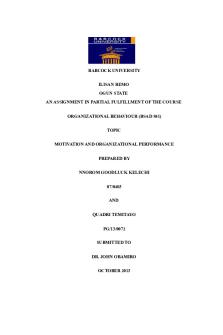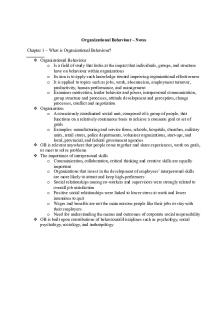Organizational Behaviour Chapter 11 Leadership PDF

| Title | Organizational Behaviour Chapter 11 Leadership |
|---|---|
| Author | Tegan Brookland |
| Course | Organizational Behaviour |
| Institution | University of Guelph-Humber |
| Pages | 7 |
| File Size | 68.8 KB |
| File Type | |
| Total Downloads | 56 |
| Total Views | 144 |
Summary
lecture notes for organizational behaviour, mcgraw-hill ryerson...
Description
Chapter 11: Leadership What is Leadership? Leadership:the ability to influence a group toward the achievement of a vision or set of goals - Source of influence may be formal (via position in organization) or not (a variety of people can be called on to perform leadership roles) Non sanctioned leadership: the ability to influence that arises outside the formal structure of the organization- may be more important that formal influence -
Organizations need both strong leadership and management Leaders to challenge the status quo, create visions of the future and inspire organizational members to achieve their visions Managers to formulate detailed plans, create efficient organizational structures and oversee day to day operations
Leadership as Supervision Three general types of theories: - Trait theories: are leaders different from others? - Behavioural theories: do leaders behave in particular ways? - Contingency theories: does the situation matter? Trait Theories - Theories that consider personality, social, physical or intellectual traits to differentiate leaders from non-leaders - Not very useful until matched with the Big Five Personality Framework - Traits can predict leadership but they are better at predicting leadership emergence than effectiveness - Leadership traits; - Extroversion - Conscientiousness - Openness - Emotional intelligence (qualified) Behavioural Theories - Theories proposing that specific behaviours differentiate leaders from non-leaders - Differences between theories of leadership - Trait theory: leadership is inherent, so we must identify the leader based on their traits - Behavioural theory: leadership is a skill set and can be taught to anyone, so we must identify the proper behaviours to teach potential leaders Important Behavioural Studies Ohio State Studies - Found two key dimensions of leader behaviour: - Initiating structure- the defining and structuring of roles
- Consideration- job relationships that reflect trust and respect University of Michigan Studies - Also found two key dimensions of leader behaviour: - Production-oriented- emphasizes the technical aspects of the job - Employee-oriented- emphasizes interpersonal relationships and is the most powerful dimension Contingency Theories - Stress that importance of considering the context when examining leadership Fiedler contingency model: - Effective group performance and depends on the proper match between the leader’s style and the degree to which the situation gives control to the leader - Least preferred co-worker (LPC) questionnaire determined whether individuals were primarily interested in: - good personal relations with co-workers and thus relationship oriented - Or productivity and thus task oriented Fiedler’s contingency situations: - Leader-member relations - Degree of confidence, trust and respect members have for leader - Task structure - Degree to which jobs are structured - Position power - Degree to which leader has control over “power”: hiring, firing, discipline, promotions, salary -Fiedler assumed that an individual's leadership style is fixed Hersey and Blanchard's situational leadership - A model that focuses on follower “readiness” - Followers can accept or reject the leader - Effectiveness depends on the followers’ response to the leaders actions - “Readiness” is the extent to which people have the ability and willingness to accomplish a specific task - A paternal model: - As the child matures, the adult releases more and more control over the situation - As the workers become more ready, the leader becomes more laissez-faire - An intuitive model that does not get much support from the research findings - Follower: able but unwilling - Leader: needs to use a supportive and participative style - Follower: both able and willing - Leader: a laissez-faire approach will work - Follower: unable but willing - Leader: needs to display high task orientation and high relationship orientation - Follower: unable and unwilling - Leader: needs to give clear and specific directions
Path-goal theory Path goal guidelines to be effective - Determine the outcomes subordinates want (good pay, interesting work, autonomy etc) - Rewards individuals with their desired outcomes when they perform well - Be clear with expectations - Let individual know what they need to do to receive rewards - Remove barriers that prevent high performance - Express confidence that individuals have the ability to perform well Path goal leadership styles - Directive - Inform subordinates of expectations, gives guidance - Supportive - Friendly and approachable, show concern for the status, well-being and needs - Participative - Consults with subordinates, solicit suggestions, takes suggestions into consideration - Achievement oriented - Sets challenging goals, expects subordinates to perform at the highest level, continually seeks improvement in performance and has confidence in highest motivations of employees Substitutes for leadership - Leader behaviours are not needed (ie employee experience, training, explicit formalized goals, rigid rules and procedures, cohesive work groups) Neutralizers of leadership - Make it impossible for leader behaviour to make any difference Inspirational Leadership - The focus is leader as communicator who inspires others to act beyond their immediate self-interest - Two contemporary leadership theories Charismatic leadership - Charisma- greek for “gift” A certain quality of an individual personality, by virtue of which they are set apart from ordinary people and treated as endowed with supernatural, superhuman or at least specifically exceptional powers or qualities - Houses charismatic leadership theory - Followers make attributions of heroic or extraordinary leadership abilities when they observe certain behaviour - Four characteristics of charismatic leaders - Have a vision - Are willing to take personal risks to achieve the vision
-
- Are sensitive to followers needs - Exhibit behaviours that are out of the ordinary Traits and personality are related to charisma People can be trained to exhibit charismatic behaviour
How charismatic leaders influence followers 1. Leaders articulates an attractive vision - Vision statement: a formal, long-term strategy to attain goals - Links past, present and future 2. Leader communicates high performance expectations and confidence in follower ability 3. Leader conveys a new set of values by setting an example 4. Leader engages in emotion-inducing and often unconventional behaviour to demonstrate convictions about the vision Charismatic leadership issues Importance of vision - Must be inspirational, value-centered, realizable and given with superior imagery and articulation Charisma works best when: - The followers task has an ideological component - There is a lot of stress and uncertainty in the environment - The leader is the upper level of the organization - Followers are low self-esteem and self-worth The dark side of charisma - Ego driven charismatic leaders allow their self-interest and personal goals to override the organization’s goals Beyond Charisma: Level 5 leaders - Four typical leadership traits - Individual capability - Team skills - Managerial competence - Ability to stimulate others to high performance - Plus one ctrical new trait - A blend of personal humility and professional will - Personal ego needs are focused toward building a great company - Take responsibility for failures and gives credit to others for successes
Transformational & Transactional leadership Transnational leaders- leaders who guide or motivate their followers in the direction of established goals by clarifying role and task requirements Characteristics of transactional leaders
-
-
-
Contingent reward - Contracts exchange of rewards for effort, promises rewards for good performance and recognizing accomplishes Management by exception (active) - Watches and searches for deviations from rules and standards, take corrective action Management by exception (passive) - Intervenes only if standards are not met Laissez-faire leader - Abdicates responsibility, avoids making decisions
Transformational leaders- inspire followers to transcend their own self-interests for the good of the organization, they can have a profound and extraordinary effect on followers Characteristics of transformational leaders - Idealized influence - Provides vision and sense of mission, instills pride, gains respect and trust - Inspirational motivation - Communicates high expectations, uses symbols to focus efforts, expresses important purposes in simple ways - Intellectual stimulation - Promotes intelligence, rationality and careful problem solving - Individualized consideration - Gives personal attention, treats each employee individually, coaches, adcives Not opposing, but complementary, approaches to leadership Best leaders are a mix of both, only one type is not enough for success Issues with transformational leadership - Basis for action - Transformational leadership works by encouraging followers to be more innovative and creative and by providing ambitious goals - Evaluation based on the research - This theory does show high correlations with desired outcomes - This style of leadership can be taught - Transformational vs. charismatic leadership - Similar concepts but transformational leadership may be considered a broader concept than charisma - Instrument-based testing shows the measures to be roughly equivalent Mentoring Mentor: - A senior employee who sponsors and support a less-experienced employee (a protege) - Good teachers present ideas clearly, listen and empathize - Two functions
-
- Career: couching, assisting, sponsoring - Psychological: counselling, sharing, acting as a role model Mentoring relationship can be formal or informal Many organizations have created formal programs to ensure mentoring relationships are available Should benefit both the mentor and protege Formal relationships are often not as effective as informal ones Mentor commitment and protege input into the relationship are critical
Self-leadership (or self-management) Self-leadership- a set of processes through which individuals control their own behaviour - How do leaders create self leaders? 1. Model self leadership 2. Encourage employees to create self-set goals 3. Encourage the use of self-rewards to strengthen and increase desirable behaviour 4. Create positive thought patterns 5. Create a climate of self-leadership 6. Encourage self-criticism Team leadership - Lead teams require other skills - Patience to share information, trust in others, willingness to give up authority and knowing when to intervene - Leading teams also require other roles - Liaisons with external constituencies - Troubleshooters - Conflict managers - Coaches Online leadership - Identification-based trust - Based on mutual understanding of each others intentions and appreciation of each others wants and desires - Leadership at a distance - Negotiations can be hindered because parties express lower levels of trust - Good leadership skills- include the ability to communicate support, trust and inspiration through electronic communication - Accurately read emotions in others messages - Writing skills are likely to become an extension of interpersonal skills Benefits of leading without authority - Latitude for creative deviance - Easier to raise questions
-
Issue focus - Freedom to focus on single issue, rather than many issues Front-line information - Often closer to the people who have the information
Contemporary issues in leadership Authentic leadership - People who know who they are, now what they believe in and value and act on those values and beliefs openly and candidly - Primary quality- trust - Build trust by: - Sharing information - Encouraging open communication - Sticking to their ideas Ethical leadership - Transformational leadership has ethical implications- change the way followers think - Charisma has ethical implications- unethical leaders use their charisma to enhance power over followers, directed towards self-serving ends - Ethical leadership reduces interpersonal conflict and increases organizational citizenship behaviours - Need to set high ethical standards and model them - Socialized charismatic leadership - Leadership that conveys values that are other-centered versus self-centred by leaders who model ethical conduct - Four cornerstones of “moral foundation of leadership” - Truth telling - Promise keeping - Fairness - Respect for the individual Servant leadership - Servant leaders go beyond their self-interest and focus on opportunities to help followers grow and develop - Don't use power to achieve ends: emphasize persuasion - Accept stewardship and actively develop followers’ potential - Results in higher level of commitment to supervisor, self-efficacy and perception of justice...
Similar Free PDFs

Chapter 2 ORGANIZATIONAL BEHAVIOUR
- 23 Pages
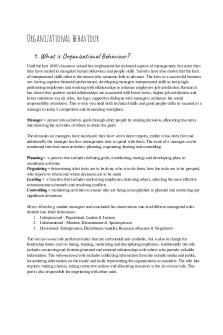
Organizational behaviour
- 67 Pages

Organizational Behaviour
- 2 Pages

organizational behavior chapter 11
- 39 Pages
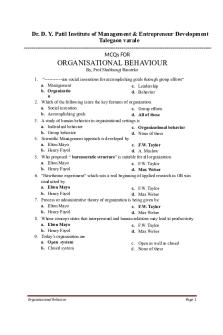
Organizational Behaviour mcqs
- 27 Pages
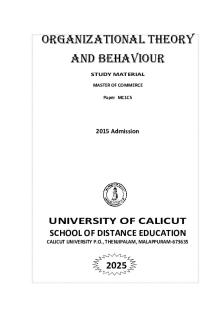
Organizational theory and behaviour
- 186 Pages
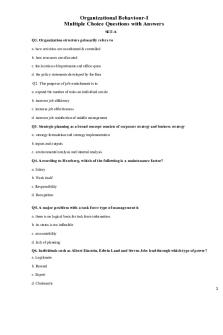
Organizational Behaviour MCQ SET
- 20 Pages
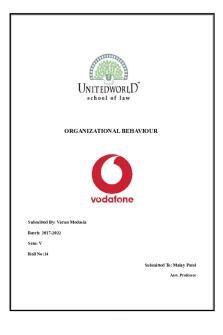
Organizational Behaviour Project
- 15 Pages

Organizational Behaviour Glossary
- 17 Pages
Popular Institutions
- Tinajero National High School - Annex
- Politeknik Caltex Riau
- Yokohama City University
- SGT University
- University of Al-Qadisiyah
- Divine Word College of Vigan
- Techniek College Rotterdam
- Universidade de Santiago
- Universiti Teknologi MARA Cawangan Johor Kampus Pasir Gudang
- Poltekkes Kemenkes Yogyakarta
- Baguio City National High School
- Colegio san marcos
- preparatoria uno
- Centro de Bachillerato Tecnológico Industrial y de Servicios No. 107
- Dalian Maritime University
- Quang Trung Secondary School
- Colegio Tecnológico en Informática
- Corporación Regional de Educación Superior
- Grupo CEDVA
- Dar Al Uloom University
- Centro de Estudios Preuniversitarios de la Universidad Nacional de Ingeniería
- 上智大学
- Aakash International School, Nuna Majara
- San Felipe Neri Catholic School
- Kang Chiao International School - New Taipei City
- Misamis Occidental National High School
- Institución Educativa Escuela Normal Juan Ladrilleros
- Kolehiyo ng Pantukan
- Batanes State College
- Instituto Continental
- Sekolah Menengah Kejuruan Kesehatan Kaltara (Tarakan)
- Colegio de La Inmaculada Concepcion - Cebu



